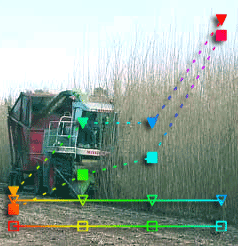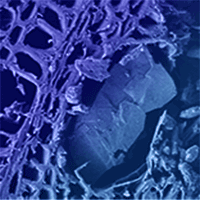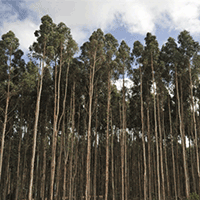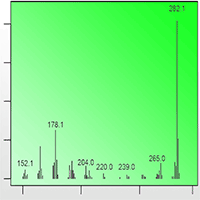Sweetgum (Liquidambar styraciflua L.) is the only species of its genus in the Western hemisphere. The species is a relatively early successional species with wide seed dispersal, fast growth and is considered one of the most adaptable tree species in North America, growing across a wide range of soil types, altitudes, and hydrologic conditions. This species has routinely been considered a lesser desired species by many forest managers trying to grow tree plantations or even in natural stands because the species tends to rapidly invade and dominate a site. However, because of sweetgum’s adaptability, ease of propagation and field planting, and fast growth rate, the tending of sweetgum as a potential crop for improved markets has been reinvigorated. Managing sweetgum also opens the possibility of development of new products and markets that supplement the traditional markets and can produce further value-added products. Increasingly, sweetgum is not viewed with as much antipathy amongst foresters and its potential as valuable resources is being rediscovered.
Keywords
, , , ,
Citation
Adams JP, Lingbeck JM, Crandall PG, Martin EM, O’Bryan CA (2015). Sweetgum: a new look. iForest 8: 719-727. - doi: 10.3832/ifor1462-008
Academic Editor
Gianfranco Minotta
Paper history
Received: Oct 02, 2014
Accepted: Apr 21, 2015
First online: Jun 23, 2015
Publication Date: Dec 01, 2015
Publication Time: 2.10 months
© SISEF - The Italian Society of Silviculture and Forest Ecology 2015
Open Access
This article is distributed under the terms of the Creative Commons Attribution-Non Commercial 4.0 International (https://creativecommons.org/licenses/by-nc/4.0/), which permits unrestricted use, distribution, and reproduction in any medium, provided you give appropriate credit to the original author(s) and the source, provide a link to the Creative Commons license, and indicate if changes were made.

Breakdown by View Type
(Waiting for server response...)
Article Usage
Total Article Views: 58065
(from publication date up to now)
Breakdown by View Type
HTML Page Views: 48481
Abstract Page Views: 3261
PDF Downloads: 4690
Citation/Reference Downloads: 60
XML Downloads: 1573
Web Metrics
Days since publication: 3830
Overall contacts: 58065
Avg. contacts per week: 106.12
Article Citations
Article citations are based on data periodically collected from the Clarivate Web of Science web site
(last update: Mar 2025)
Total number of cites (since 2015): 9
Average cites per year: 0.82
Publication Metrics
by Dimensions ©
Articles citing this article
List of the papers citing this article based on CrossRef Cited-by.
(1)
Allen JA (1990)Establishment of bottomland oak plantations on the Yazoo National Wildlife Refuge Complex. Southern Journal of Applied Forestry 14 (4): 206-210.
Online |
Gscholar
(2)
Bacon CG, Zedaker SM (1987)Third-year growth response of loblolly pine to eight levels of competition control. Southern Journal of Applied Forestry 11 (2): 91-95.
Online |
Gscholar
(3)
Biblis EJ, Lee W-C (1984)Properties of sheathing-grade plywood made from sweetgum and southern pine. Wood and Fiber Science 16 (1): 86-92.
Gscholar
(4)
Bonner FT, Karrfalt RP (2008)The woody plant seed manual. Agriculture Handbook 727, USDA Forest Service, Washington, DC, USA, pp. 1223.
Online |
Gscholar
(5)
Brand MH, Lineberger RD (1988)In vitro adventitious shoot formation on mature-phase leaves and petioles of
Liquidambar styraciflua L. Plant Science 57 (2): 173-179.
CrossRef |
Gscholar
(6)
Brand MH, Lineberger RD (1991)The effect of leaf source and developmental stage on shoot organogenic potential of sweetgum (
Liquidam-bar styraciflua L.) leaf explants. Plant Cell, Tissue and Organ Culture 24 (1): 1-7.
CrossRef |
Gscholar
(7)
Bridgwater A, Toft A, Brammer J (2002)A techno-economic comparison of power production by biomass fast pyrolysis with gasification and combustion. Renewable and Sustainable Energy Reviews 6 (3): 181-246.
CrossRef |
Gscholar
(8)
Brown R, Schultz R, Kormanik P (1981)Response of vesicular-arbuscular endomycorrhizal sweetgum seedlings to three nitrogen fertilizers. Forest Science 27 (2): 413-420.
Online |
Gscholar
(9)
Bryan WC, Kormanik PP (1977)Mycorrhizae benefit survival and growth of sweetgum seedlings in the nursery. Southern Journal of Applied Forestry 1 (1): 21-23.
Online |
Gscholar
(10)
Bushnell DI (1909)Choctaw of Bayou Lacomb, St. Tammany Parish, Louisiana. Washington Government Printing Office, Washington, DC, USA, pp. 23.
Gscholar
(11)
Cassens DL (2007)Hardwood lumber and veneer series: sweetgum. Extension Publication FNR-300-W, Purdue University, West Lafayette, IN, USA, pp. 4.
Online |
Gscholar
(12)
Chang SX (2003)Seedling sweetgum (
Liquidambar styraciflua L.) half-sib family response to N and P fertilization: growth, leaf area, net photosynthesis and nutrient uptake. Forest Ecology and Management 173 (1-3): 281-291.
CrossRef |
Gscholar
(13)
Clatterbuck WK, Hodges JD, Burkhardt EC (1984)Cherrybark oak development in natural mixed oak-sweetgum stands - preliminary results. In: Proceedings of the “3
rd Biennial Southern Silvicultural Research Conference” (Shoulders E ed). Southern Forest Experiment Station, USDA Forest Service, Atlanta, GA, USA, pp. 438-444.
Gscholar
(14)
Clatterbuck WK, Hodges JD (1988)Development of cherrybark oak and sweet gum in mixed, even-aged bottomland stands in central Mississippi, USA. Canadian Journal of Forest Research 18 (1): 12-18.
CrossRef |
Gscholar
(15)
Clatterbuck W, Meadows J (1993)Regenerating oaks in the bottomlands. In: Proceedings of the Symposium “Oak Regeneration: Serious Problems, Practical Recommendations” (Loftis DL, McGee CE eds). Knoxville (TX, USA) 8-10 Sep 1992. General Technical Report SE-84, Southeastern Forest Experiment Station, USDA Fo-rest Service, Asheville, NC, pp. 184-195.
Gscholar
(16)
Clatterbuck WK, Armel GR (2011)PB1799 site preparation for natural regeneration of hardwoods. Publication no. PB1799, University of Tennessee Extension, Knoxville, TX, USA, pp. 11.
Online |
Gscholar
(17)
Coyle DR, Coleman MD, Aubrey DP (2008)Above-and below-ground biomass accumulation, production, and distribution of sweetgum and loblolly pine grown with irrigation and fertilization. Canadian Journal of Forest Research 38 (6): 1335-1348.
CrossRef |
Gscholar
(18)
D’Anieri P, Zedaker SM, Seiler JR, Kreh RE (1990)Glyphosate translocation and efficacy relationships in red maple, sweetgum, and loblolly pine seedlings. Forest Science 36 (2): 438-447.
Online |
Gscholar
(19)
DOE (2007)Biomass multi-year program plan. Office of the Biomass Program, Energy Efficiency and Renewable Energy, US Department of Energy, Washington, DC, USA.
Gscholar
(20)
Guo Y, Lockhart BR, Ka TT (1998)Effect of nitrogen and phosphorus fertilization on growth in a sweetgum plantation in southeastern Arkansas. Southern Journal of Applied Forestry 22 (3): 163-168.
Online |
Gscholar
(21)
Gurbuz I, Yesilada E, Demirci B, Sezik E, Demirci F, Baser KH (2013)Characterization of volatiles and anti-ulcerogenic effect of Turkish sweetgum balsam (
Styrax liquidus). Journal of Ethnopharmacology 148 (1): 332-336.
CrossRef |
Gscholar
(22)
Hamel PB, Chiltoskey MU (1975)Cherokee plants and their uses - a 400 year history. Herald Publishing Co., Sylva, NC, USA, pp. 64.
Gscholar
(23)
Hare R (1976)Rooting of American and Formosan sweetgum cuttings taken from girdled and nongirdled cuttings. Tree Planters’ Notes 27 (4): 6-7.
Gscholar
(24)
Hartnett DC, Krofta DM (1989)Fifty-five years of post-fire succession in a southern mixed hardwood forest. Bulletin of the Torrey Botanical Club 116 (2): 107-113.
CrossRef |
Gscholar
(25)
Hodges JD (1997)Development and ecology of bottomland hardwood sites. Forest Ecology and Management 90 (2-3): 117-125.
CrossRef |
Gscholar
(26)
Hoey MT, Parks CR (1991)Isozyme divergence between eastern Asian, North American, and Turkish species of
Liquidambar (Hamamelidaceae). American Journal of Botany 78 (7): 938-947.
CrossRef |
Gscholar
(27)
Hoey MT, Parks CR (1994)Genetic divergence in
Liquidambar styraciflua,
L. formosana, and
L. acalycina (Hamamelidaceae). Systematic Botany 19 (2): 308-316.
CrossRef |
Gscholar
(28)
Iversen CM, Norby RJ (2008)Nitrogen limitation in a sweetgum plantation: implications for carbon allocation and storage. Canadian Journal of Forest Research 38 (5): 1021-1032.
CrossRef |
Gscholar
(29)
Johnson RL, Krinard R (1983)Regeneration in small and large sawtimber sweetgum-red oak stands following selection and seed tree harvest: 23-year results. Southern Journal of Applied Forestry 7 (4): 176-184.
Online |
Gscholar
(30)
Johnson RL, Krinard RM (1988)Growth and development of two sweetgum-red oak stands from origin through 29 years. Southern Journal of Applied Forestry 12 (2): 73-78.
Online |
Gscholar
(31)
Karadeniz B, Ulker Z, Alpsoy L (2011)Genotoxic and cytotoxic effects of storax in vitro. Toxicology and Industrial Health 29 (2): 181-186.
CrossRef |
Gscholar
(32)
Kim M, Sommer H, Dean JD, Merkle S (1999)Transformation of sweetgum via microprojectile bombardment of nodule cultures. In Vitro Cellular and Developmental Biology - Plant 35 (1): 37-42.
CrossRef |
Gscholar
(33)
Kline KL, Coleman MD (2010)Woody energy crops in the southeastern United States: two centuries of practitioner experience. Biomass and Bioenergy 34 (12): 1655-1666.
CrossRef |
Gscholar
(34)
Kormanik PP (1986)Lateral root morphology as an expression of sweetgum seedling quality. Forest Science 32 (3): 595-604.
Online |
Gscholar
(35)
Kormanik PP (1990)Liquidambar styraciflua L. sweetgum. In: “Silvics of North America - Vol. 2, Hardwoods” (Burns RM, Honkala BH eds). Agriculture Handbook 654, USDA Forest Service, Washington, DC, USA, pp. 400-405.
Online |
Gscholar
(36)
Kormanik PP, Bryan WC, Schultz RC (1977)Influence of endomycorrhizae on growth of sweetgum seedlings from eight mother trees. Forest Science 23 (4): 500-505.
Online |
Gscholar
(37)
Kuprianova LA (1960)Palynological data contributing to the history of Liquidambar. Pollen et Spores 2 (1): 71-88.
Gscholar
(38)
Larsen T, Gnegy J, Olinger H (1983)Glyphosate for release of loblolly pine (
Pinus taeda, hardwood competition). Proceedings of the Southern Weed Science Society 36: 235-238.
Gscholar
(39)
Lee N, Wetzstein HY, Sommer HE (1985)Effects of quantum flux density on photosynthesis and chloroplast ultrastructure in tissue-cultured plantlets and seedlings of
Liquidambar styraciflua L. towards improved acclimatization and field survival. Plant Physiology 78 (3): 637-641.
CrossRef |
Gscholar
(40)
Li JH, Bogle AL, Klein AS (1997)Interspecific relationships and genetic divergence of the disjunct genus
Liquidambar (Hamamelidaceae) inferred from DNA sequences of plastid gene
matK. Rhodora 99 (899): 229-240.
Gscholar
(41)
Lingbeck JM, O’Bryan CA, Martin EM, Adams JP, Crandall PG (2015)Sweetgum: an ancient source of beneficial compounds with modern benefits. Pharmcognosy Review 9 (17) 1-11.
CrossRef |
Gscholar
(42)
Lockhart BR, Ezell AW, Hodges JD, Clatterbuck WK (2006)Using natural stand development patterns in artificial mixtures: a case study with cherrybark oak and sweetgum in east-central Mississippi, USA. Forest Ecology and Management 222 (1): 202-210.
CrossRef |
Gscholar
(43)
Martin E, Duke J, Pelkki M, Clausen E, Carrier D (2010)Sweetgum (
Liquidambar styraciflua L.): extraction of shikimic acid coupled to dilute acid pretreatment. Applied Biochemistry and Biotechnology 162 (6): 1660-1668.
CrossRef |
Gscholar
(44)
Mc Nabb K, VanderSchaaf C (2005)Growth of graded sweetgum 3 years after root and shoot pruning. New Forests 29 (3): 313-320.
CrossRef |
Gscholar
(45)
McConnell TE, Shi SQ (2011)Partially hydrolyzing southern hardwoods: possibilities for biofuels and wood composite manufacturing. Forest Products Journal 61 (3): 235-239.
CrossRef |
Gscholar
(46)
Meadows JS, Stanturf JA (1997)Silvicultural systems for southern bottomland hardwood forests. Forest Ecology and Management 90 (2-3): 127-140.
CrossRef |
Gscholar
(47)
Merkle S, Cunningham M (2011)Southern hardwood varietal forestry: a new approach to short-rotation woody crops for biomass energy. Journal of Forestry 109 (1): 7-14.
Online |
Gscholar
(48)
Mitchell R, Zutter B, Green T, Perry M, Gjerstad D (1993)Spatial and temporal variation in competitive effects on soil moisture and pine response. Ecological Applications 3 (1): 167-174.
CrossRef |
Gscholar
(49)
Nelson LE, Switzer GL (1990)Sweetgum half-sib seed source response to nitrogen and phosphorus fertilization in Mississippi. Soil Science Society of America Journal 54 (3): 871-878.
CrossRef |
Gscholar
(50)
Nelson LE, Switzer GL (1992)Response of nine-year-old plantation sweetgum to nitrogen fertilization in Mississippi. Southern Journal of Applied Forestry 16 (3): 146-150.
Online |
Gscholar
(51)
Nelson LE, Switzer GL, Shelton MG (1995)Aboveground net primary productivity and nutrient content of fertilized plantation sweetgum. Soil Science Society of America Journal 59 (3): 925-932.
CrossRef |
Gscholar
(52)
Nelson L, Ezell A, Yeiser J (2006)Imazapyr and triclopyr tank mixtures for basal bark control of woody brush in the southeastern United States. New Forests 31 (2): 173-183.
CrossRef |
Gscholar
(53)
Nikolaeva MG (1969)Physiology of deep dormancy in seeds. Izdatel’stvo Nauka, Leningrad, Russia, pp. 220.
Gscholar
(54)
Norby RJ, Iversen CM (2006)Nitrogen uptake, distribution, turnover, and efficiency of use in a CO
2-enriched sweetgum forest. Ecology 87 (1): 5-14.
CrossRef |
Gscholar
(55)
Ocsel H, Teke Z, Sacar M, Kabay B, Duzcan SE, Kara IG (2012)Effects of oriental sweet gum storax on porcine wound healing. Journal of Investigative Surgery 25 (4): 262-270.
CrossRef |
Gscholar
(56)
Orsted AS (1863)L’Amérique centrale: recherches sur sa flora et sa géographie physique. Résultats d’un voyage dans les états de Costa Rica et de Nicaragua exécuté pendant les années 1846-1848 [Central America: research on its flora and its physical geography. Results from a trip in the states of Costa Rica and Nicaragua executed during the years 1846-1848]. B. Luno par FS Muhle, Copenhagen, Denmark, pp. 18. [in French]
Gscholar
(57)
Perry M, Mitchell R, Zutter B, Glover G, Gjerstad D (1994)Seasonal variation in competitive effect on water stress and pine responses. Canadian Journal of Forest Research 24 (7): 1440-1449.
CrossRef |
Gscholar
(58)
Porcher FP (1869)Resources of the southern fields and forests, medical, economical, and agricultural. Walker, Evans and Cogswell, Richmond, VA, USA, pp. 733.
Gscholar
(59)
Rieckermann H, Goldfarb B, Cunningham M, Kellison R (1999)Influence of nitrogen, photoperiod, cutting type, and clone on root and shoot development of rooted stem cuttings of sweetgum. New Forests 18 (3): 231-244.
CrossRef |
Gscholar
(60)
Rink G, Dell T, Switzer G, Bonner F (1979)Use of the Weibull function to quantify sweetgum germination data. Silvae Genetica 28 (1): 9-12.
Online |
Gscholar
(61)
Ruiz-Sanchez E, Ornelas JF (2014)Phylogeography of
Liquidambar styraciflua (Altingiaceae) in Mesoamerica: survivors of a Neogene widespread temperate forest (or cloud forest) in North America? Ecology and Evolution 4 (4): 311-328.
CrossRef |
Gscholar
(62)
Sannigrahi P, Hu F, Pu Y, Ragauskas A (2012)A novel oxidative pretreatment of loblolly pine, sweetgum, and miscanthus by ozone. Journal of Wood Chemistry and Technology 32 (4): 361-375.
CrossRef |
Gscholar
(63)
Sassner P, Galbe M, Zacchi G (2008)Techno-economic evaluation of bioethanol production from three different lignocellulosic materials. Biomass and Bioenergy 32 (5): 422-430.
CrossRef |
Gscholar
(64)
Scott DA, Burger JA, Kaczmarek DJ, Kane MB (2004)Growth and nutrition response of young sweetgum plantations to repeated nitrogen fertilization on two site types. Biomass and Bioenergy 27 (4): 313-325.
CrossRef |
Gscholar
(65)
Shmulsky R, Saucier C, Howard I (2008)Composite effect of bolt-laminated sweetgum and mixed hardwood billets. Journal of Bridge Engineering 13 (5): 547-549.
CrossRef |
Gscholar
(66)
Shmulsky R, Shi S (2008)Development of novel industrial laminated planks from sweetgum lumber. Journal of Bridge Engineering 13 (1): 64-66.
CrossRef |
Gscholar
(67)
Sommer HE, Brown CL (1980)Notes: embryogenesis in tissue cultures of sweetgum. Forest Science 26 (2): 257-260.
Online |
Gscholar
(68)
Sova M (2012)Antioxidant and antimicrobial activities of cinnamic acid derivatives. Mini Reviews in Medicinal Chemistry 12 (8): 749-767.
CrossRef |
Gscholar
(69)
Speck FG (1941)A list of plant curatives obtained from the Houma Indians of Louisiana. Primitive Man 14 (4): 49-73.
CrossRef |
Gscholar
(70)
Sullivan J, Lagrimini LM (1993)Transformation of
Liquidambar styraciflua using
Agrobacterium tumefaciens. Plant Cell Reports 12 (6): 303-306.
CrossRef |
Gscholar
(71)
Sutter E, Barker P (1985)In vitro propagation of mature
Liquidambar styraciflua. Plant Cell, Tissue and Organ Culture 5 (1): 13-21.
CrossRef |
Gscholar
(72)
TMS (2010)1st quarter 2010. Timber Mart-South Market News Quarterly, vol. 15, no. 1.
Gscholar
(73)
TMS (2014)1st quarter 2014. Timber Mart-South Market News Quarterly, vol. 19, no. 1, pp. 52.
Online |
Gscholar
(74)
Uemura K (1983)Late Neogene
Liquidambar (Hamamelidaceae) from the southern part of northeast Honshu, Japan. Memoirs of the National Science Museum 16: 25-36.
Gscholar
(75)
Wang H, Srinivasan R, Yu F, Steele P, Li Q, Mitchell B, Samala A (2012)Effect of acid, steam explosion, and size reduction pretreatments on bio-oil production from sweetgum, switchgrass, and corn stover. Applied Biochemistry and Biotechnology 167 (2): 285-297.
CrossRef |
Gscholar
(76)
Wendling I, Brondani G, Dutra L, Hansel F (2010)Mini-cuttings technique: a new ex vitro method for clonal propagation of sweetgum. New Forests 39 (3): 343-353.
CrossRef |
Gscholar
(77)
Wenger KF (1953)The sprouting of sweetgum in relation to season of cutting and carbohydrate content. Plant Physiology 28 (1): 35-48.
CrossRef |
Gscholar
(78)
Wetzstein HY, Sommer HE (1982)Leaf anatomy of tissue-cultured
Liquidambar styraciflua (Hamamelidaceae) during acclimatization. American Journal of Botany 69 (10): 1579-1586.
CrossRef |
Gscholar
(79)
Williams JW, Shuman BN, Webb T III, Bartlein PJ, Leduc PL (2004)Late-Quaternary vegetation dynamics in North America: scaling from taxa to biomes. Ecological Monographs 74 (2): 309-334.
CrossRef |
Gscholar
(80)
Wolfe JA (1985)Distribution of major vegetational types during the Tertiary. Geophysical Monograph Series 32: 357-375.
Online |
Gscholar
(81)
Wright J, Cunningham M (2008)Sweetgum plantations for sawtimber, energy, pulp, and other uses. Forest Landowners 67 (3): 26-28.
Gscholar
(82)
Wright HJ (1981)Vegetation east of the Rocky Mountains 18.000 years ago. Quaternary Research 15 (2): 113-125.
CrossRef |
Gscholar
(83)
Wu C, Dixon G, Muench S, Sandberg C (1983)The use of glyphosate for pine release in the Midsouth. Proceedings of the Southern Weed Science Society 36: 230-234.
Gscholar
(84)
Wyman CE, Spindler DD, Grohmann K (1992)Simultaneous saccharification and fermentation of several lignocellulosic feedstocks to fuel ethanol. Biomass and Bioenergy 3 (5): 301-307.
CrossRef |
Gscholar
(85)
Yang B, Wyman CE (2008)Pretreatment: the key to unlocking low- cost cellulosic ethanol. Biofuels, Bioproducts and Biorefining 2 (1): 26-40.
CrossRef |
Gscholar
(86)
Zhao X, Cheng K, Liu D (2009)Organosolv pretreatment of lignocellulosic biomass for enzymatic hydrolysis. Applied Microbiology and Biotechnology 82 (5): 815-827.
CrossRef |
Gscholar


















